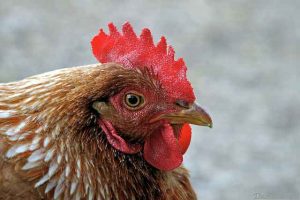
At first it went like clockwork. The first batch of chickens safely grew to adult hens, and they began to lay eggs.
After some time, the neighbor began to walk sad - laying hens began to give less eggs and moved barely.
The whole thing turned out to be the presence of parasites. Which ones, it was possible to find out at a closer inspection. If fleas have chickens, how to deal with them, read the article.
Like animals, birds are also susceptible to insect attacks. Very often, they are struck by an independent type of flea, called chicken. They often chase farm birds, but are also found in domestic canaries and parrots. It is quite difficult to get rid of them, but vital, otherwise it will lead to a decrease in the number of eggs and death of individuals due to the spread of infections.
The content of the article:
- 1 general information
- 2 How to get rid of chicken fleas
- 3 Manifestation of parasites
- 4 Fleas in chickens: treatment and prevention
- 5 How to protect chicken from lice: the basics of treatment and prevention
- 6 Why are they dangerous?
- 7 The main methods of treatment
- 8 Is it possible to prevent the appearance of parasites?
- 9 External parasites of poultry and how to deal with them
- 10 How to determine if a chicken has fleas
- 11 How to deal with chicken lice?
- 12 Fighting Chicken Fleas
general information
Chicken parasites are arranged in almost the same way as other types of fleas: a small body of about 1-2 mm, strong and elongated hind legs for jumping, the absence of wings and a brown-chocolate color. What do chicken fleas look like? They are similar to small hanging moles, always dark in color.
Therefore, chicken fleas very rarely attack a person, and they don’t even live in houses if there is no bird cage. They feed exclusively on blood. Often their accumulation can be found in areas of the chicken body uncovered by feathers, because it is easier to bite through the skin there.
The female, although she cannot leave the victim, she will never lay her eggs on it. For this flea has certain muscles that allow you to shoot eggs (3-6 pieces) over a fairly distant distance.
The next day, a larva emerges from them, more like a small worm. She grows and feeds intensely, and at the necessary moment she pupates. An adult will only be able to emerge from a pupa if it is kept warm at a temperature of 40 degrees for some time.
What are dangerous for birds and humans
If the flea problem is not resolved in time, they will simply kill the chicken. The poor bird can neither eat nor drink and will die of exhaustion. Parasites also carry dangerous diseases, such as plague, brucellosis, salmonellosis. Especially often the bites of insect pests infect birds with helminths, and subsequently a person becomes the owner of worms.
How to get rid of chicken fleas
Bird owners who encounter parasites are wondering how to remove fleas in the chicken coop quickly and efficiently. For this, you can use both certain chemical preparations and alternative methods.
Chemicals
Insecticides should be used both for processing the animals themselves and for the chicken coop.For each of these cases, you need your own drugs. To get rid of fleas on the birds themselves, you can use similar products for cats and dogs, you just need to ensure they are rubbed well so that the chicken does not try the poison.
Among the best can be identified:
- Drops of Beaphar. They are completely natural, without chemistry. As a poison, Nim tree seed oil is used. The term of their protective action is about a month, so after this period the treatment of fleas needs to be repeated.
- Drops of Hartz. Metoprene insecticide is used. Chicken product is not recommended due to its low toxicity. It is rubbed along the entire head and neck. The result appears after 24 hours.
- Insecticides Get, Cucaracha, Tetrix can be used for processing the place of keeping birds, but at the time of their absence. Traps and repellers are not used, as they are absolutely ineffective.
Folk remedies
To combat chicken fleas, it was invented to use wormwood and tansy, as well as ash. The easiest way is to hang or spread these plants around the chicken house, and their smell will drive insects out very quickly. In addition, you can prepare a decoction:
- Tansy and (or) wormwood pour boiling water in the proportions of 1: 3.
- Leave for the night to insist.
- The next day, treat the whole room with a decoction, including perches, floors, walls, corners and doors.
It is important not only to know how to get rid of chicken fleas correctly, but also to clearly follow all the instructions. Only then will the forces and resources invested in the struggle pay off. In addition, it is better to completely prevent the occurrence of these parasites, which means that preventive measures should be taken regularly.
Chicken fleas are parasites that live on birds, both domestic and wild. Why do fleas start? Very often it’s hard for owners of a large farm to keep track of all the pets. This is especially true for birds.
When the simultaneous release of insects begins, the animal may die from nervous and physical exhaustion associated with bites. In addition, the bird can infect the entire chicken coop.
A rational issue in such situations is the conduct of pest control. But before exposing your chickens to chemical attack, you need to find out which particular parasite torments them. Each pest has its own characteristics, this affects the behavior of infected individuals.
All About Chicken Fleas
Fleas are considered the most common external parasites in chickens. Depending on the species, they can live in feathers or on the skin of a bird. Fleas jump perfectly, which allows them to easily move around the chicken coop. In addition, the female of this insect does not have a clutch of eggs in the form of a nest, but scatters them in different directions to increase the area of distribution.
If at least one flea has appeared in the chicken coop or poultry farm, then in seven to ten days all individuals will be infected with parasites.
Chicken fleas, the fight against which has been ongoing for more than one millennium, are representatives of insects, which are characteristic to have:
1. Three-segmented body:
- head;
- chest;
- abdomen.
2. A couple of antennae on the head.
3. Three pairs of legs and wings.
The peculiarity of the development cycle is the presence of metamorphoses, which makes immature stages excellent, not similar to adults. Some larvae do not have legs, antennae, or wings.
Manifestation of parasites
Flea-infected birds have skin irritations. At the same time, they constantly clean their feathers and scratch themselves. Also, chickens become somewhat nervous, restless. They begin to bathe periodically in the dust, thereby trying to get rid of annoying insects.
If the parasites have not yet managed to multiply, then their presence can be determined by a decrease in productivity and an increase in feed intake.Fleas suck blood from birds, therefore, in order to make up for losses, the animal's body requires more vitamins.
Thus, feed intake increases dramatically. Some mistakenly believe that sick individuals are simply trying to "seize stress." In fact, the reason is biologically explainable: they need to produce new blood in order to stay alive.
Fighting chicken fleas - how to get rid and bring out
Chicken fleas, the fight against which is sometimes carried out by the most radical methods, bring great problems to their master. Therefore, it would be wise to get rid of parasites as quickly as possible. A set of events can be carried out in several stages:
- Dusting. This method involves the use of a pulverulent preparation. It is spread on the litter. The method is quite inconvenient, since it requires a large number of dust boxes.
- Spraying. The most common type of pest control. The difficulty of using a balloon sprayer is the need for thorough processing of walls and gratings, which is quite difficult to do.
- Irrigation using an aerosol. For this, special electric generators are used. This method is very simple and effective.
In order for pest control to be most effective, it is necessary to find out exactly what kind of fleas your chickens are infected before it. There are several varieties of these parasites:
- Suction flea. It is difficult to remove as a result of their attachment to the bird's head. They do not separate from their carrier, which requires pest control of the chicken itself.
- European type chicken flea. Carried by pigeons, sparrows, people and animals. He does not live on his master, but is on it only for sustenance. It can be found in the nests. Such fleas can be etched with an aerosol.
Fleas in chickens: treatment and prevention
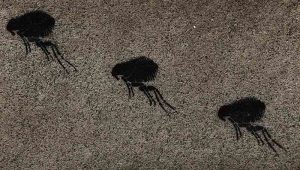
Fleas, like lice and bedbugs, belong to the class of external parasites, the body of which consists of three parts - the head, abdomen and thoracic region. Fleas in chickens, the photo shows this, has three pairs of legs, a pair of antennae and a trachea for breathing.
If fleas in chickens are destroyed, then in the chicken coop, it is necessary to fight rodents that are carriers of parasites. This is especially true in the fall, when rats and mice tend to move to commercial buildings.
In recent years, methods have been used to simultaneously destroy the rodents themselves and their ectoparasites - fleas and ticks. For this, mixtures of insecticides and rodenticides are used, mixing them with the bait.
When fleas appear, chickens constantly scratch and clean their feathers. Symptoms with a small number of fleas are not apparent. But any decrease in bird productivity or an increase in feed intake may indicate the appearance of external parasites.
If fleas are found in chickens, treatment is carried out with the following basic chemicals: organophosphorus compounds, synthetic pyrethroids, carbamates and pyrethroid insecticides. You can not mix these funds together.
Insecticides are available in the form of water-dispersed formulations, emulsifiable concentrate and soluble powders, as well as in the form of baits or dust-like preparation - dust. Similar drugs are sold in veterinary pharmacies and are ready for use.
Of plant insecticides, pyrethrin is very effective. It is the main ingredient for aerosols. Preparations based on chlorinated hydrocarbon are prohibited for use in poultry houses. Their components accumulate in poultry and eggs.
When treating poultry houses with insecticides, respirators and protective gloves must be used. Getting on the treated surface, the flea dies within 24 hours. If the fleas in chickens do not disappear, treatment should be repeated after 1-2 weeks. Mechanical methods of killing fleas are ineffective.
Some poultry farmers of the past generation believe that fleas are afraid and cannot tolerate wormwood. Others claim that she will not confuse hungry fleas, and a Persian or Caucasian chamomile (not a pharmacy) is a more effective means.
This plant contains flea-toxic substances - pyrethrins. But to obtain the effect you need a large number of leaves and stems of the plant. Fleas can be carriers of pathogens such as hepatitis (B and C), salmonella, sources of typhus and skin diseases.
Young fleas are black in color, and mature individuals have a brownish tint. Usually fleas in chickens (photo enlarged) reach a size of 1-5 mm. Due to the special structure of the limbs, fleas can move around the body of a bird, clinging to different inclinations.
Preventive measures against the spread of fleas are aimed, first of all, at creating the appropriate conditions for breeding chickens: keeping houses clean, carrying out deratization, wet cleaning. The destruction of fleas on poultry must be carried out in accordance with the recommendations of veterinary specialists.
How to protect chicken from lice: the basics of treatment and prevention
Chicken for the owner is not only a source of eggs, but also meat. Sometimes your bird can suffer from parasites. Consider a very common problem - chicken fleas.
Why do lice appear?
Fleas in chickens can appear even in owners who closely monitor the sanitary conditions of pets.
And why do lice appear in your birds:
- unsanitary living conditions for birds;
- contact with wild birds (sparrows, pigeons and crows), which can become carriers of parasites;
- contact with other animals, sometimes carriers of chicken lice can become pets (cats, dogs, cows and so on).
You will not notice the infection of the chickens right away, since lice are small insects that are 1-5 mm in size, as in the photo. Within a month, parasites breed from an egg to an adult and not only on one bird, but immediately on all.
Why are they dangerous?
Many owners believe that fleas in chickens are not an important disease and do not require treatment. However, this is a big mistake, the appearance of parasites leads to serious consequences.
What harm can chicken lice do:
- they can become carriers of infectious diseases;
- can also infect the bird with helminths;
- due to itching and uncomfortable sensations, can lead to weight loss and death;
- with long contact with parasites, chickens have problems with the number of eggs, as well as poor health.
Symptoms of the appearance of parasites
An infected bird must be shown to a veterinarian who will diagnose and prescribe treatment. In the photo below you can see chicken fleas.
What are the signs of chicken in the presence of blood-sucking parasites:
- she becomes nervous and restless;
- bites itself with a beak or pulls out feathers;
- partial baldness of feathers or down;
- weight loss and productivity, sometimes appetite;
- mortality of chickens and young chickens.
If at least one symptom is found, it is necessary to examine all the chickens and separate the precisely infected ones, although, most likely, they are already all such. Then urgently begin to deal with the problem.
The main methods of treatment
The main question at the first manifestations of the symptoms of parasites becomes how to get rid of them. Immediately after detecting the signs of fleas, as shown in the photo, you need to start solving this problem.
Traditional way
Fighting parasites in the traditional way or with chemicals is most effective. For chickens, anti-flea drugs are harmless, but lice, killing the nervous system, are killed.
What flea control agents are used:
- Drops for chickens, such as Neotmazan, Front Line, Bars and others.
- Sprays for chickens, and sometimes aerosols for people are used. This is done only on the testimony of a specialist, strictly following the instructions. For example: Get, Nyuda and others.
- The liquid for processing the premises, the most common "Karbofoz". To destroy parasites, it is imperative to process the floor, walls and perches of the chicken coop.
All known drugs act only on adult lice, but after about 1-2 weeks they hatch again from eggs. Therefore, it is necessary to fight bloodsuckers again in 7-10 days.
Folk methods
Owners of chickens faced the problem of lice even before drugs appeared. They used various folk remedies.
The most effective folk methods for removing chicken fleas:
- Use deterrent odors such as tansy and rosemary branches, chamomile flowers, and the smell of rosemary and eucalyptus essential oils.
- Treat the birds with vinegar diluted in half with water. The most effective is the combination of vinegar and kerosene in a ratio of 1: 1.
- An excellent tool is a mixture of kerosene, ammonia and benzene in equal proportions. This mixture is applied not only to chickens, but also to process their home.
Typically, hens are bred in the village, so folk remedies to get fleas out are at hand. Traditional methods of dealing with them are more costly, for which you often have to go to the city.
Is it possible to prevent the appearance of parasites?
Prevention is the best way to prevent fleas from chickens. Veterinarians note that sand baths with ash help fight the appearance of lice.
What measures should be taken to avoid the occurrence of fleas in birds:
- regular processing of the place of stay with boiling water or steam;
- litter change and cleansing of the remains of chickens;
- limit contact with wild birds;
- constantly inspect pets for lice.
Getting rid of fleas is a long and difficult process, therefore it is better to prevent their appearance. The best effect is achieved by owners who treat in a timely manner and constantly monitor their chickens.
External parasites of poultry and how to deal with them
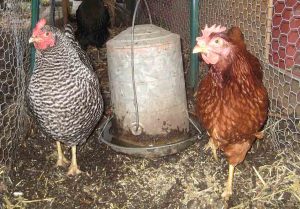
The presence of parasites such as lice (poohoedov and poyoedy) depends on the conditions of their transmission from bird to bird.
In modern poultry farming, the problem with feather- and poo-eaters has become less acute than before, since one farm contains a small number of age groups.However, with the enlargement of production areas and livestock, the likelihood of the spread of insect parasites increases.
For example, a northern chicken tick, which has adapted for a long time to live without a host, can be carried by birds, as well as equipment and clothing of service personnel, wild birds and rodents.
In contrast, a decrease in the bird landing area creates favorable conditions for the distribution of northern chicken ticks among them, which complete their life cycle on birds. Domestic flies are a problem with any type of content.
If there are places for reproduction and a suitable temperature, then their number can rapidly increase. While flies themselves are usually not a particular problem for birds, they can create inconvenience to adjacent human dwellings and cause complaints about their increasing numbers.
Certain ectoparasites of birds (pooh and peroids) actually feed on dead cells of the skin and its derivatives. However, for many parasites, the skin serves as a habitat through which they suck out blood or lymph, receive heat and shelter.
Only external parasites (pooh and peroids) during the life cycle are on one host and are transmitted to another only upon contact. Others are freely transmitted from bird to bird through environmental objects. Some of them are narrowly specific in relation to owners.
Ticks of poultry and chickens attack birds only at night, and during the day they hide in crevices and nests. These differences in the behavior and biology of external parasites are very important when choosing control measures. Ticks cannot be successfully controlled by any one method.
This is due to the fact that their various species lead an unequal lifestyle. Therefore, to select a control method, it is necessary to accurately determine the type of parasite.
How to determine if a chicken has fleas
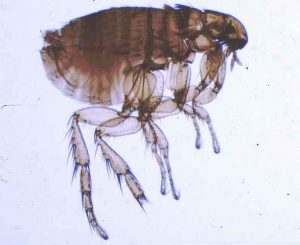
With a weak infection, symptoms may appear to a lesser extent.
Any inexplicable decline in productivity or an increase in feed intake should suggest the possible presence of external parasites in birds.
Lice and northern chicken ticks can be found simply by sorting out feathers. But in order to see these small parasites, you need bright lighting and good vision. Adequate illumination can be obtained using a light fixture attached to the head with a special, elastic bandage.
If the found parasite cannot be identified immediately, then it can be sent either to the laboratory or to the entomologist.Blood-sucking parasites (bed bugs and chicken mites) that attack birds for food only are more difficult to detect.
Nest material, dust, and other materials that accumulate in the room can be laid out for inspection in a white bath. To detect parasites that eat at night, you need to conduct nightly checks of birds. Post-mortem testing in the laboratory is necessary to identify internal organs.
Chicken fleas - what is
Fleas (order Siphonaptera) parasitize in adulthood, but live freely at the larval stage. Adults have a size of about 1.5 mm. They have a rigid, laterally compressed body, a piercing-sucking mouth, short antennae in a recess and long legs adapted for jumping.
They have a complete conversion cycle. At the larval stage, they have no legs, they look like a caterpillar, and the pupa is in a miniature cocoon. The color of fleas varies from brown to black; they feed on blood from various species of hosts.
After 1–2 weeks, tiny larvae hatch from eggs, which feed mainly on “feces” of fleas and clots of undigested blood secreted by the female to provide food for developing larvae.
A fully grown larva weaves a silk cocoon, entangling various particles of dust and dirt with threads. Depending on the temperature, the stationary stage of the pupa lasts from one week to several months.
Coming out of the pupal cocoons, young fleas seek the owner, suck blood from him and become sexually mature in a few days. Immature fleas can live without food for several weeks or months. Adults can live without food for several weeks, but in the presence of hosts live from several months to a year.
Flea sucking
Adults usually attach to the scalp, often in groups of one hundred or more. Their mouth organs penetrate deep into the skin, so these parasites are difficult to remove. Suction fleas are unique among poultry fleas.
European chicken flea
Its owners can be chickens, pigeons, azure birds, sparrows and tree swallows, as well as humans, dogs, chipmunks, rats and squirrels. This flea remains on the birds as much as it needs for food. At the same time, its immature stages can be found both in nests and near them (Fig. European chicken flea Ceratophyllusgallinae).
In Scotland, to control the European chicken flea (Ceratophyllus gallinae), pyrethroid pyrethrin in the form of a 0.125-0.25% spray solution is used in the litter and perches.
The penetration of poultry, dogs, cats and rats should not be allowed, since in this case they will constantly replenish the flea colony. Flea propagation is prevented by sunlight, warm, dry weather, high humidity and cold.
How to deal with chicken lice?
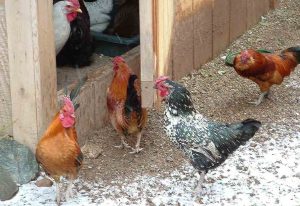
Imagine what kind of torment geese and ducks, rooks and starlings endure during long spring and autumn flights! Domestic chickens are also susceptible to infection by these insects.
Chicken meat and eggs are dietary products, they include in their diet a large part of the world's population.In our country, more and more poultry farms are being built, chickens are bred on farms and on personal farms.
Poultry and feathers are used as a by-product of poultry farming. Production waste is also used for the production of meat and bone meal. Bird droppings are also a valuable organic fertilizer.
Chicken louse
Unlike its counterparts living in the wild, poultry do not have to fight for their existence - they are not threatened with death from hunger and cold or death from the claws of a predator. However, chickens, like any other living creature, are at risk of disease, they can be attacked by parasites, such as helminths, lice and fleas.
The course of the disease is associated with increased anxiety. Chickens, as a rule, sort out feathers for a long time in search of parasites and often peck them along with feathers. As a result, bare sections appear on the neck and in the cloaca area. Adult chickens lose weight, reduce egg production. Young growth does not grow well; chicks that are infected can die if the necessary measures are not taken in time.
How to fight
Modern veterinary products allow infected chickens to completely get rid of parasites and recover, restoring health and productivity. Of the drugs, the most effective are insecticides, which are used as part of ointments, processed solutions and sprays.
The treatment is carried out by spraying the bird with a 2% aqueous emulsion of low toxic oxamate or 0.25% stomazan emulsion in the form of sprays. In parallel with the floor content, ash-sand baths with the addition of insecticides should be installed, also add them to the litter.
Fighting Chicken Fleas
For the fight against chicken fleas, their destruction and elimination, various drugs are used that are used for the same purpose in cats and dogs. They remove parasites not only in chicken coops and on laying hens, but also on other birds, for example, parrots and canaries.
The most relevant and common means of fighting chicken fleas: Bars, Frontline, Stronghold, Advantage, Dana. The latter are most optimal in quality / price / safety combinations. Processing of houses can be carried out by any insecticidal substances used to destroy bugs, cockroaches and fleas.
The most popular and common of them are: Karbofos, Tetrix, Get, Cucaracha and Tsifoks. They are presented in the form of microencapsulated agents and concentrates. Also, many buyers opt for drugs in spray cans: Raid, Raptor and Combat. However, they are not as effective as the ones listed above and are almost more economical.
All of the above products are more suitable for controlling fleas in small chicken coops with a small population, usually up to twenty chickens. Larger nurseries are treated with special solutions, substances and agents:
- butox. It is suitable for treating chicken coops and spraying the birds themselves. The drug is presented in the form of ampoules, soluble in water;
- Deltamethrin powder.It has the form of a powder and is used both for application on plumage of chickens and rubbing into their skin, and for the treatment of houses.
When spraying the premises, the bird should be removed from there (removed) to another place at least for several hours, and preferably a day. Immediately after processing, it is necessary to leave everything as it is, so that all the larvae undergo etching.
And immediately before the “settling” of the layers, the chicken coop should be cleaned, changed the litter in it, ventilated and wet-cleaned. It is also worth noting that each chicken must be treated separately, and not sprayed all livestock from the spray gun.
After some time, all procedures related to the fight against chicken fleas should be repeated. Eggs laid by laying hens during and immediately after their processing should also not be eaten.
I keep chickens and ducks all the time, and it happens that parasites attack a bird. Of course, you need to regularly inspect birds for parasites in order to prevent its death. When parasites are found, I use the Dinkur remedy. It helps against ticks, fleas, lice, and lice. On the package there is a table for the preparation of a solution for treating poultry and for treating rooms.
In order not to have to deal with the removal of parasites in birds, it is necessary to keep it clean. Always before putting the bred chickens into the chicken coop, my husband carefully removes it. cleans and whitens completely - and the ceiling, and walls and spills lime on the floor. Lime also disinfects well. Also, you can never use the nests that have remained from past chickens - the nests are made new, and the platforms are also thoroughly whitened. After such treatment, if the chickens are healthy, then no flea pests cling to them.
My mother always has lime in her chicken coop and fresh sawdust on the floor. We are happy to eat only homemade eggs, and in return we bring her ashes so that chicken fleas, eat-oats and other insects do not start. Hens bathe in ash, which is always in the chicken coop, and there are no problems with plumage. This year, for the first time, the Chik-tonic preparation was given to our birds, it may have coincided, but mother didn’t have “naked” hens, and they started to race better.
I grew up in the village and such nonsense as reducing the lack of chickens due to fleas - the first time I hear. Almost all chickens have fleas, it is very difficult to keep track of them so that they are not there. For example, in the village in every household there are chickens and they go around the garden and yard, and how to save them from fleas? Keep locked up? Then they won’t scamper! They need the will, and you "commentators" do not engage in nonsense!
But there are a lot of bugs, cockroaches and fleas! I think it's better to keep chickens in cages. On the one hand, it will be convenient for centralized management, on the other hand, it helps to maintain dry and clean conditions in the chicken coop, thus reducing the number of bugs, cockroaches and fleas in the chicken enclosure. So such poultry equipment has an automatic manure removal system and evaporation panels. All this provides an optimally comfortable indoor microclimate. In addition, you can also fight chicken fleas with an appropriate medicine supplement.
We are able to supply you with such equipment for the poultry farm, if you need, contact me to find out detailed information.